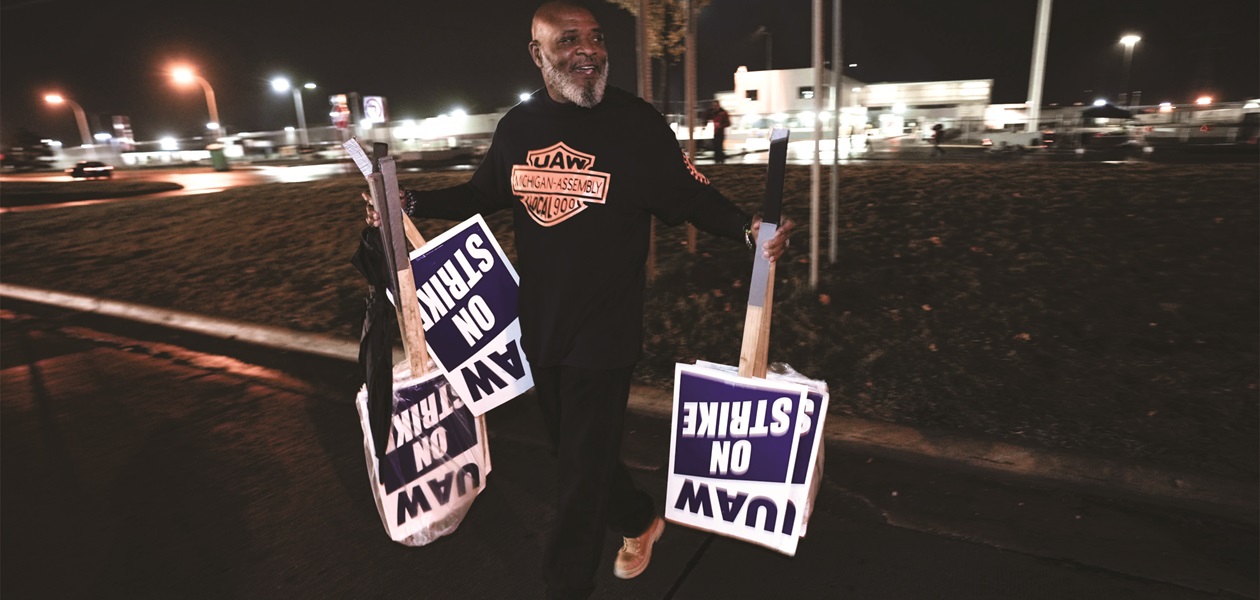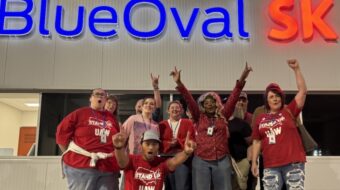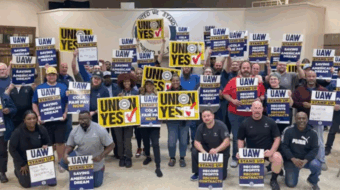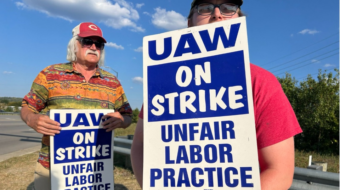
DETROIT—United Auto Workers bargainers with Ford reached a tentative agreement with the Detroit Three auto firm on Oct. 25, union President Shawn Fain and Chuck Browning, its vice-president for Ford, announced on a video the union posted late Wednesday evening. The deal features big raises and company givebacks.
“Today we announce a major victory in our Stand Up strike,” a smiling Fain said, referring to the union’s its strategy of leaving the Detroit Three uncertain about which key plant the union strikers might shut next. The strike began at midnight Sept. 14-15, at three big plants, one per car company. It’s now up beyond 40 plants.
This tentative pact gives Ford workers a 25% raise over its 4-1/2 years, larger than the combined raises of 23% cumulatively over 2001-22, Browning said. And there’s an immediate 11% ratification bonus on top of the pay hike, along with major company givebacks, notably restoration of cost of living adjustments (COLAs), which the Detroit Three abolished in 2009.
“Every extra $100 million we took out of the company” over the life of the pact, “we took out because of you,” Fain declared. “We told Ford to pony up, and they did. They put 50% more on the table than they did when we began.”
“We took the strike to a new phase” starting Oct. 23, “with maximum effect,” Fain explained. “On Monday, we called the Sterling Heights Assembly plant”—the 6,800-worker Stellantis plant—“to stand up.”
Then, on Tuesday, he said, “the UAW family at Arlington (Texas) Assembly,” the 5,000 Local 276 workers at GM’s plant there, “answered the call.” The two plants are the firms’ biggest moneymakers.
“Ford knew what was coming for them on Wednesday,” so they settled, Fain said. One Ford shop steward said had the two sides not agreed, UAW would have walked out of Ford’s iconic—and enormous—River Rouge complex in Dearborn, Mich.
The agreement is still subject to approval by the presidents of Ford locals, who will discuss it in Detroit starting Oct. 29 before voting on whether to send it to the 57,000 Ford members for a one-worker one-vote election.
Meantime, Ford workers who walked will return to their jobs. Ford employs more UAW members than GM (46,000) and Stellantis, formerly Fiat/Chrysler (43,000). The total number of UAW strikers at all three combined approached 45,000.
The Ford tentative agreement now puts even more pressure on GM and Stellantis to settle, Fain said, briefly abandoning the smile he wore through much of the video. “The last thing they want is for Ford to get back to full capacity while they mess around and lag behind,” he commented. The two holdouts will not want to allow Ford vehicles to be the only ones re-entering the market.
Browning filled in details on the deal. The base pay plus the COLAs would produce a 33% increase over the pact’s life, not far from the union’s initial demand. Some of the raises will be even larger: 68% in starting wages, and some workers at Ford’s Sterling Heights Axle plant will get up to 85%.
The biggest raise will go to the temps, who will also be on a 3-year, not an 8-year, track to regular full-time work. Some 3% of Ford workers are temps, compared to 12% at Stellantis and 5%-10% at GM, depending on the work at a particular plant, Automotive News calculates.
“For decades, the temps have been abused and exploited. Some will get raises of over 100%,” said Browning. “And UAW members at Ford will see more in general wage increases over the next 4-1/2 years than they have over the last 22 combined.”
The union won the right to strike over plant closings, thus slowing, if not stopping, the exodus of car plants from the U.S. and Canada to less-regulated and lower-paying jurisdictions, such as Mexico, courtesy of the now-dead North American Free Trade Agreement. “That means they [Ford] can’t keep devastating communities and closing plants with no consequences,” said Fain.
The cost-of-living adjustments, along with the raises, are the biggest deal in the tentative pact.
UAW, Ford, GM, and what was then Fiat/Chrysler had to abolish COLAs as part of a federal loan guarantee for the latter two car companies when the 2008 Wall Street financier-caused Great Recession pushed both into bankruptcy. Ford did not go broke but was “me-too” on COLAs.
That loan guarantee pact also ended raises for pensioners and mandated a two-tier wage system and an eight-year period to reach the top of the auto firms’ wage scales. The tiers are gone, at least at Ford’s Sterling Axle plant, Browning said. And the pensioners will get raises, too, said Fain, though he didn’t give out numbers.
Some issues went unmentioned in the Fain-Browning presentation. One was the union’s demand for more time with families and less mandatory overtime via 32-hour weeks at 40-hours’ pay.
Another was the future of converting current plants from manufacturing internal combustion engines and drive trains to electric battery-powered vehicles, part of the goal the car companies and UAW agreed on with the Democratic Biden administration as part of the nation’s commitment to combat global warming by drastically cutting fossil fuel use.
But those EV plants, often built with foreign firm partners and—at least for the first two—in union-hostile Kentucky and Tennessee, would employ fewer workers than traditional auto plants. That left a dual problem: Numbers and whether the contract would cover them.
While Fain and Browning did not mention EVs, the union had reached victory with GM on covering the EV workers under the master contract—but only after planning to walk from the big Arlington, Texas, plant. Facing that threat to its big moneymaker, GM caved on the EV issue but has been stubborn on other conflicts, leading the union to call the Arlington workers out anyway.
We hope you appreciated this article. At People’s World, we believe news and information should be free and accessible to all, but we need your help. Our journalism is free of corporate influence and paywalls because we are totally reader-supported. Only you, our readers and supporters, make this possible. If you enjoy reading People’s World and the stories we bring you, please support our work by donating or becoming a monthly sustainer today. Thank you!










